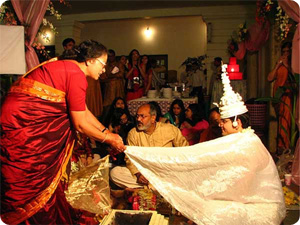
Bengali pre-wedding rituals are very delightful to look at. The ceremonies conducted before the marriage symbolize that they eagerly look forward to the important day in the life of the couple, who are soon going to tie the nuptial knot. Bengalis have a very charming way of pampering the bride and the groom before the wedding, and for the purpose, they have set aside certain rituals that largely include pujas and exchange of gifts. This is often followed by feasting, which can be both simple and lavish. Go through the following lines to know all about the Bengali pre-wedding rituals.
Bengali Pre-Wedding Customs Adan Pradan Literally termed as give and take, the adan pradhan ritual involves the matching of ancestral lines (bangsas) of the bride and the groom, in the presence of a purohit (priest). This way, the two families ensure that the couple going to tie the wedding knot does not belong to the same gotra (lineage). Aashirwad (Patri Patra) The marriage alliance between the two families is confirmed by patri patra, a ritual that takes place a couple of days before the wedding. The purohit arrives at the residence of the bride or the groom, with an idol of Lord Narayan, to conduct patri patra. After the ritual is over, the bride's family pays a visit to the groom and blesses him in the presence of the priest. This is reciprocated by the groom's family. Vridhi Puja Vridhi puja is conducted a day before the wedding in the remembrance of the ancestors of the bride and groom. Beautiful Rangoli is made and Lord Narayan is worshipped. According to the tradition, the vridhi puja is conducted by a paternal uncle of the bride or the groom. Tradition demands that the uncle and the bride/groom should stay on a liquid diet during the vridhi puja. Dodhi Mangal Conducted at the dawn on the day of the wedding, Dodhi Mangal is a ceremony in which ten married women fetch water from a nearby pond in order to bathe the bride/groom. Thereafter, they serve a lavish feast to the bride/groom. The lip smacking meal consists of macher laija bhaja (fried fish), jal dhala bhaja (rice cooked in water), curd and chiruya. Wedding Piris Piris, wooden seats painted and decorated by a relative or friend, are used to seat the bride and the groom during the wedding ceremony. The wedding piris is usually brought a day before or on the wedding day, to the bride's home. Exchange of gifts takes place between the two families. When the wedding piris is handed over, conch shells are blown, accompanied by ululation. Gae Halud Tattva Gae halud tattva ritual takes place before the turmeric ceremony. The groom�s parents send some gifts for the bride. The gift, called the gae halud tattva, usually consists of six saris, cosmetics, fish, assorted sweets, curd, paan, dhaan and durba. A relative of the groom is chosen to deliver the gifts at the bride's residence. The relative, along with an entourage of servants bearing the gifts, are welcomed to the bride's place by blowing of conch shells. The bearers are rewarded with sweets and bakshish for their service. Adhibas Tattva In order to reciprocate the honor shown by the groom's family, the bride's family sends the former gifts, which is called abhidas tattva. The gift usually includes a saree for the groom's mother, and fish, sweets, curd, paan, dhaan, and durba. The gifts are arranged on a brass plate, borne by the servants from the bride's house. The bearers are warmly welcomed by the groom's family. Snan Snan is the bathing ritual that is individually followed by the bride and the groom, in late afternoon on the wedding day. During the snan ceremony, a couple of married women apply the paste of turmeric and oil on the bride/groom�s hair and body. Thereafter, the bride/groom is given a new set of clothes that is gifted by his/her in-laws. The old worn clothes of the bride/groom are given away to the napti (barber). Sankha Porana Sankha porana is the tradition of wearing shankha porana or conch shell bangles that have been dipped in turmeric water. This tradition is followed by the bride after bathing and dressing up in a new sari. Dressing Up The Bride Dressing up the bride is a ritual in itself, in the traditional Bengali marriage. The bride is adorned with jewelry and crown. When she is fully dressed and ready to go to the mandap, her face is adorned with a design of mukut using the chandan paste. Mandap In the preparation of mandap, two banana trees are planted and rice paste is used to make a large alpana. The mandap is beautified with fresh flowers and flashy lights. |
BENGALI PRE-WEDDING RITUALS
Related Posts: Bengali Wedding Ceremony


